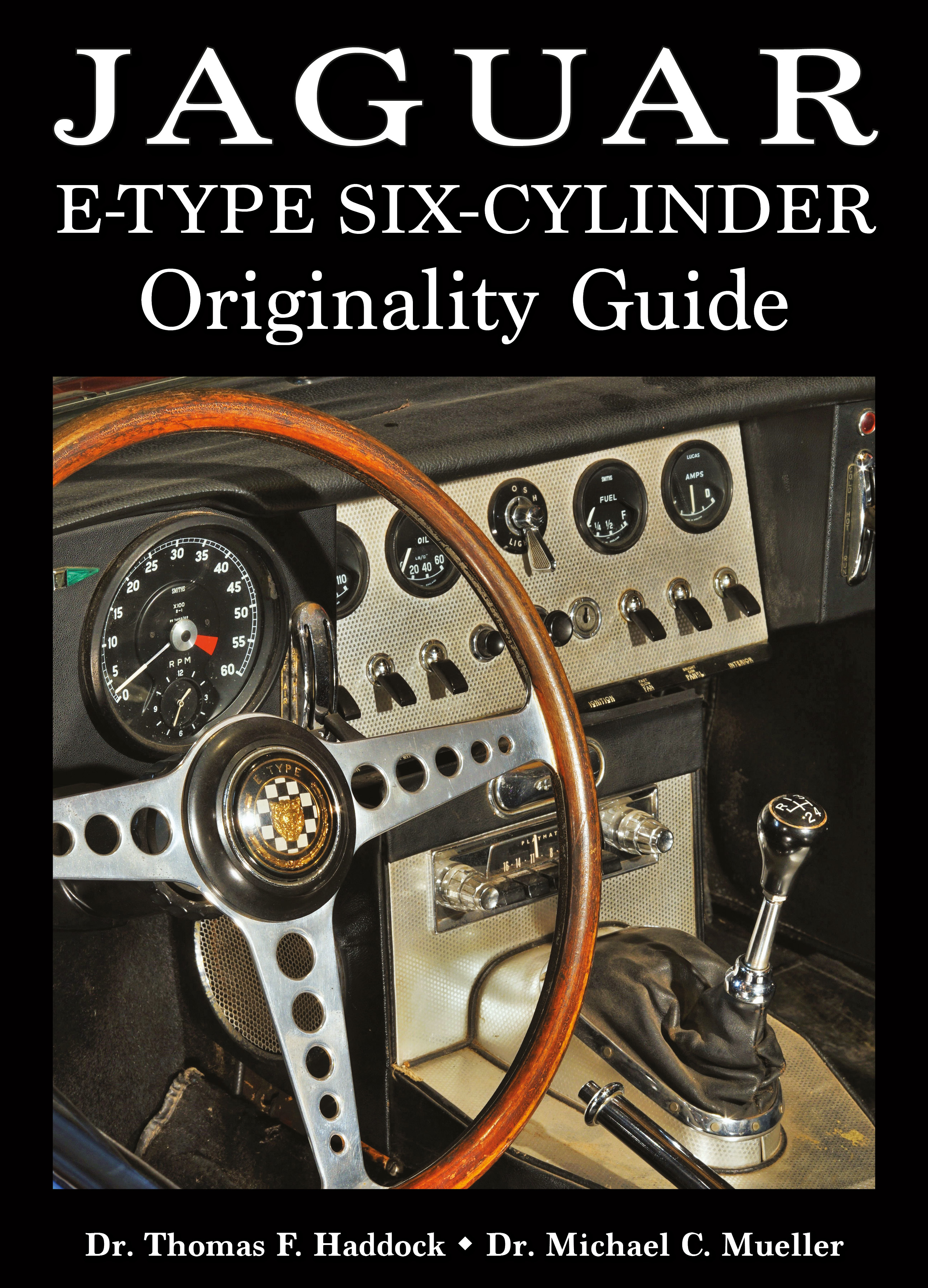
|
|
|
|
|
|
N-11Y
|
|

|
|
|
|
|
|
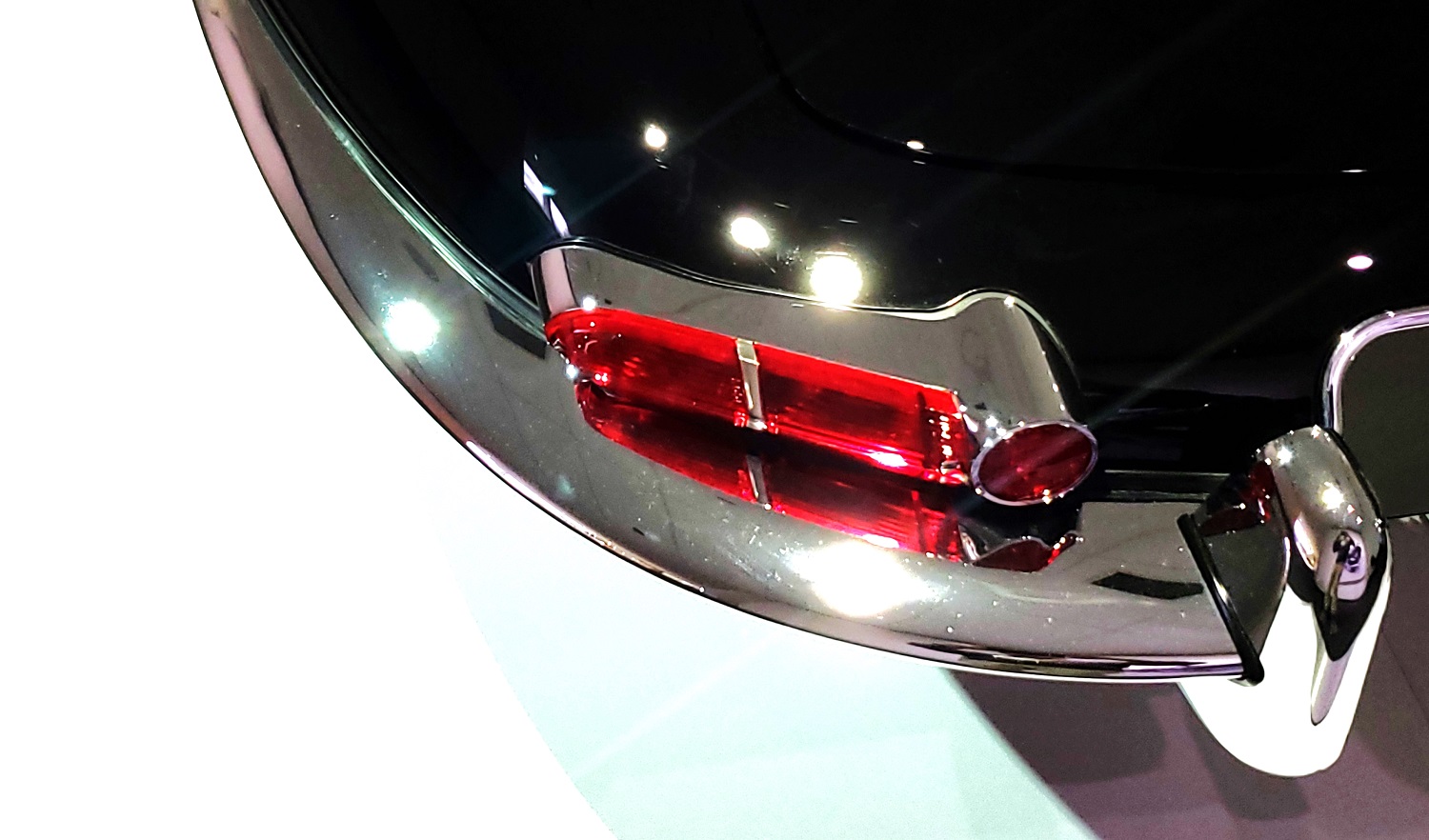
|
|
Tail light
Left rear view of a restored 3.8-liter roadster.
|
|
|
|
|
|
SU HD8 carburetors
|
|
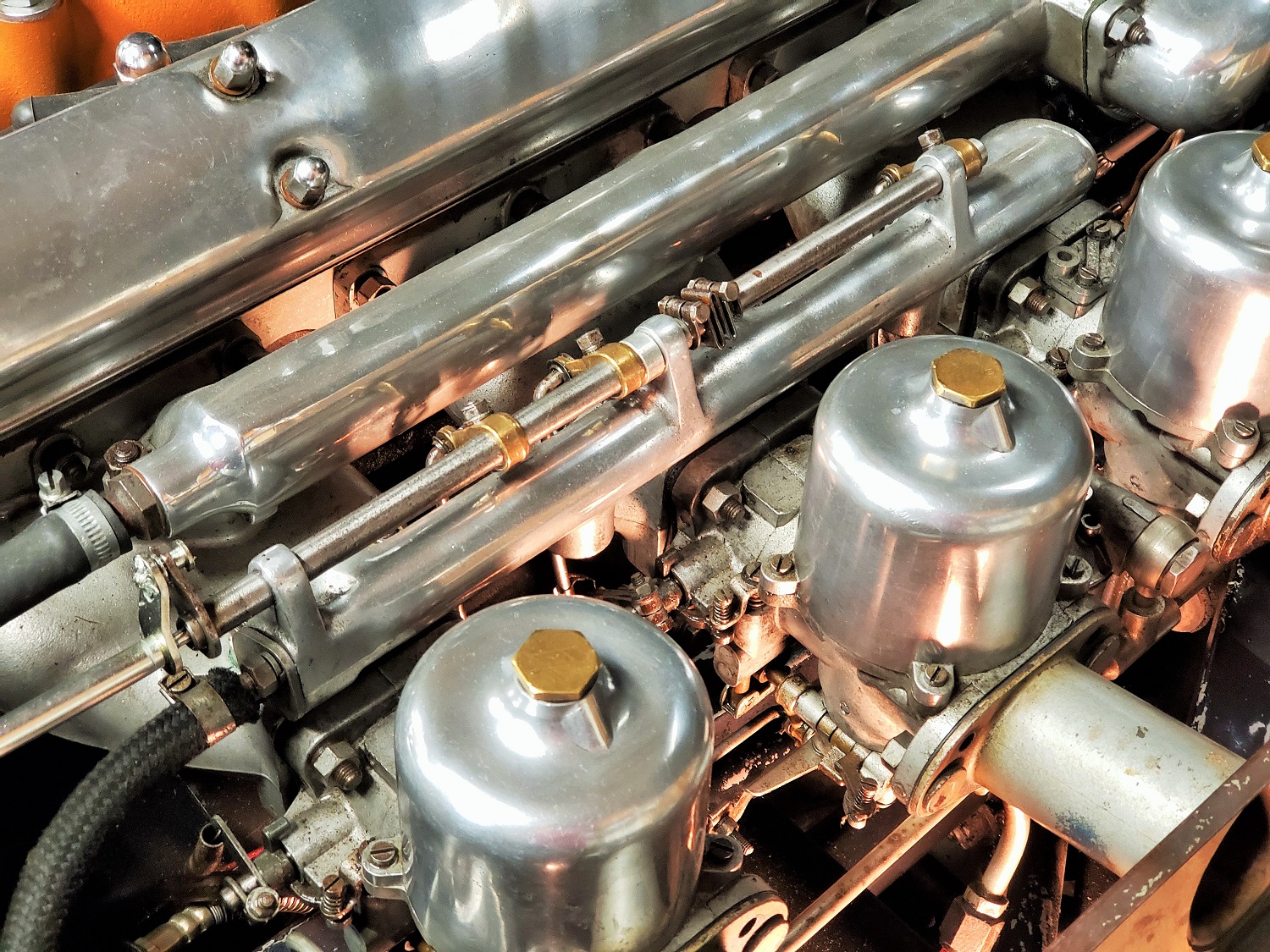
|
|
|
|
|
|
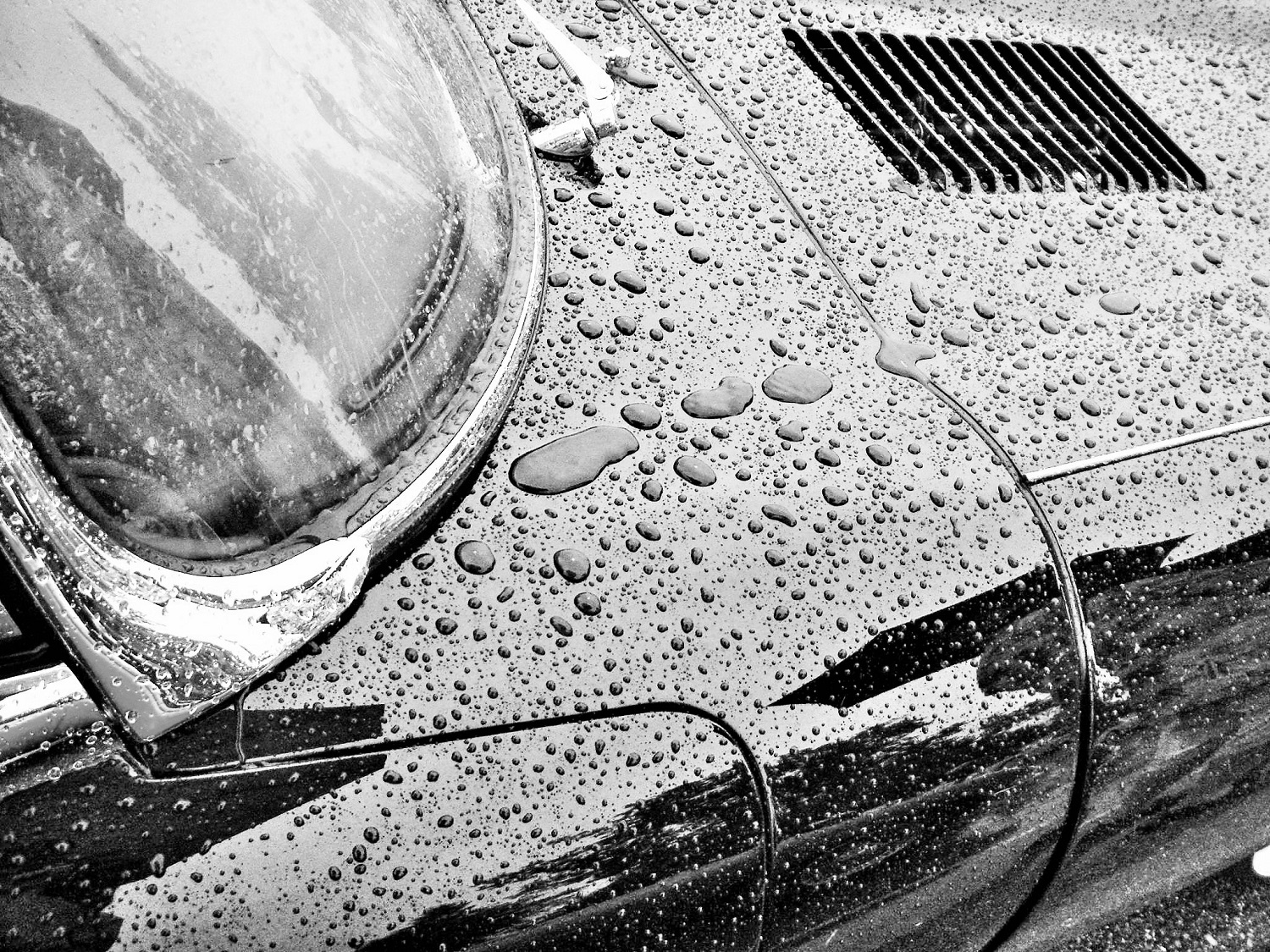
|
|
E-type in the rain
|
|
|
|
|
|
Dunlop wire wheels
Early-style chromed 72-spoke double-laced Dunlop wire wheels during transport.
These are the type of wheels used on Series 1 E-types. In some cases, they were painted instead of chromed.
|
|
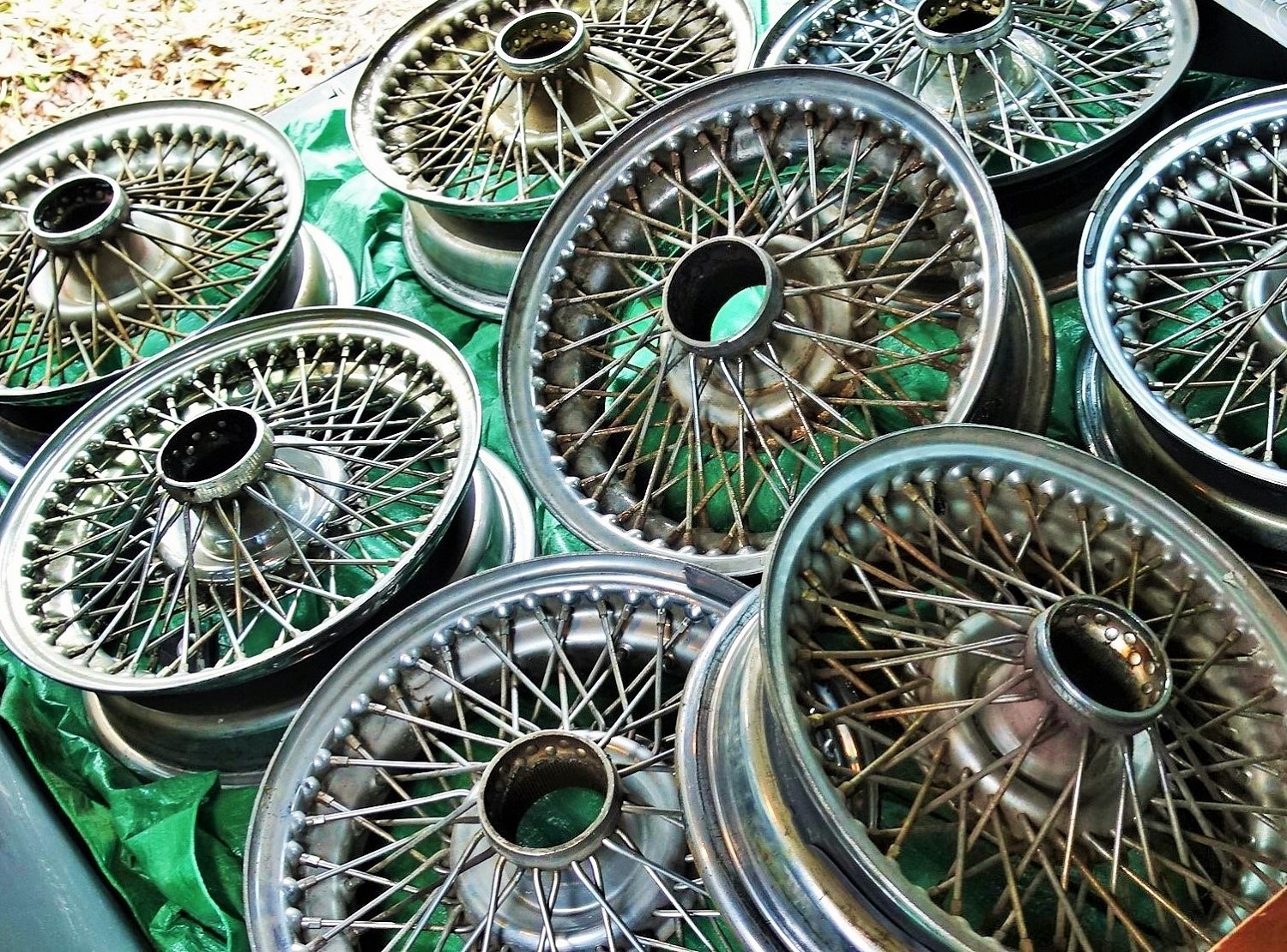
|
|
|
|
|
|
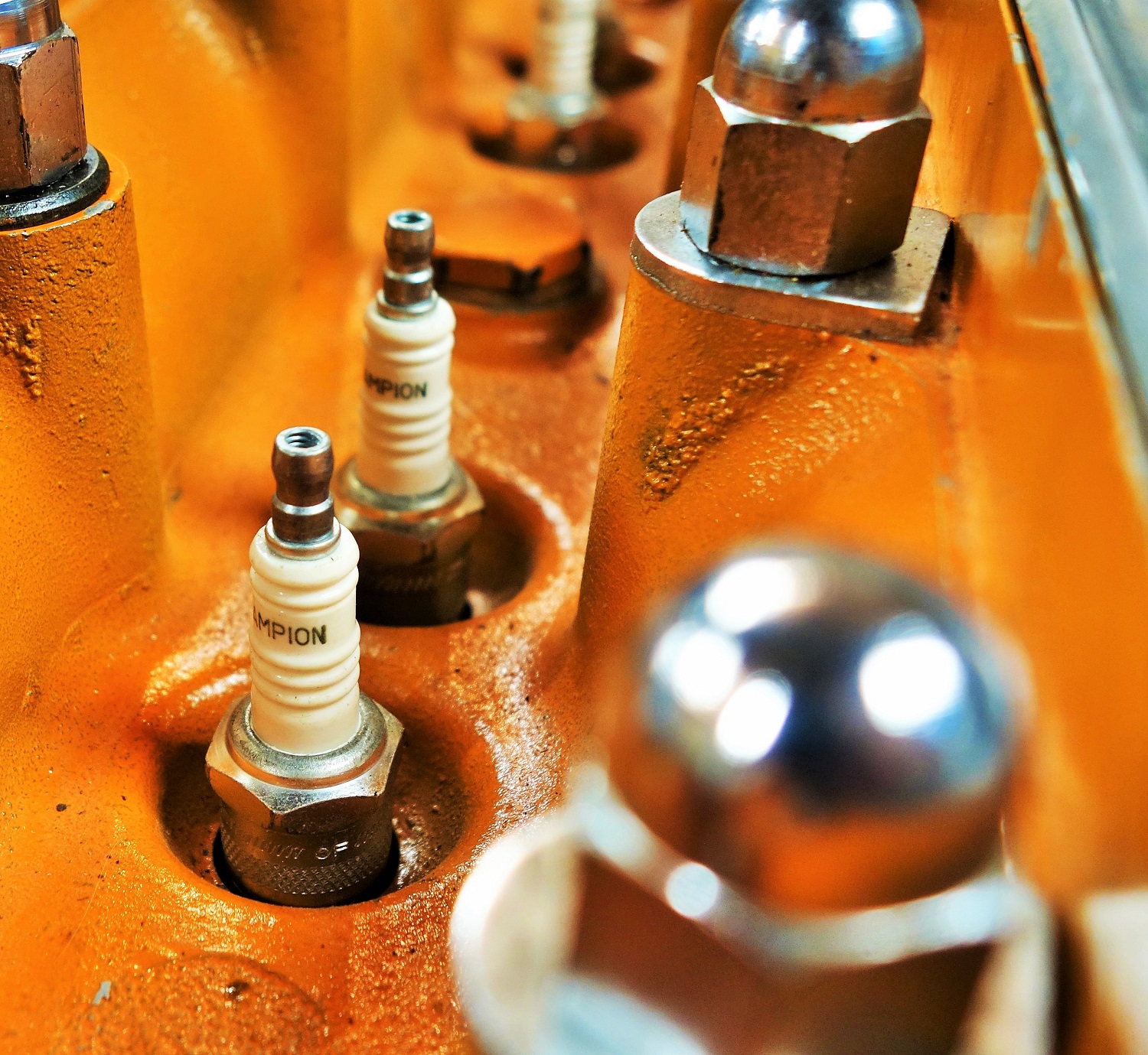
|
|
Champion spark plugs in an XK engine
Champion spark plugs were the type oringally fitted to Jaguar E-types.
The spark-plug location in the center of the head well made them very easy to access, in contrast to some cars with different engine configurations.
|
|
|
|
|
|
A home shop in the evening
E-type in an informal setting.
|
|
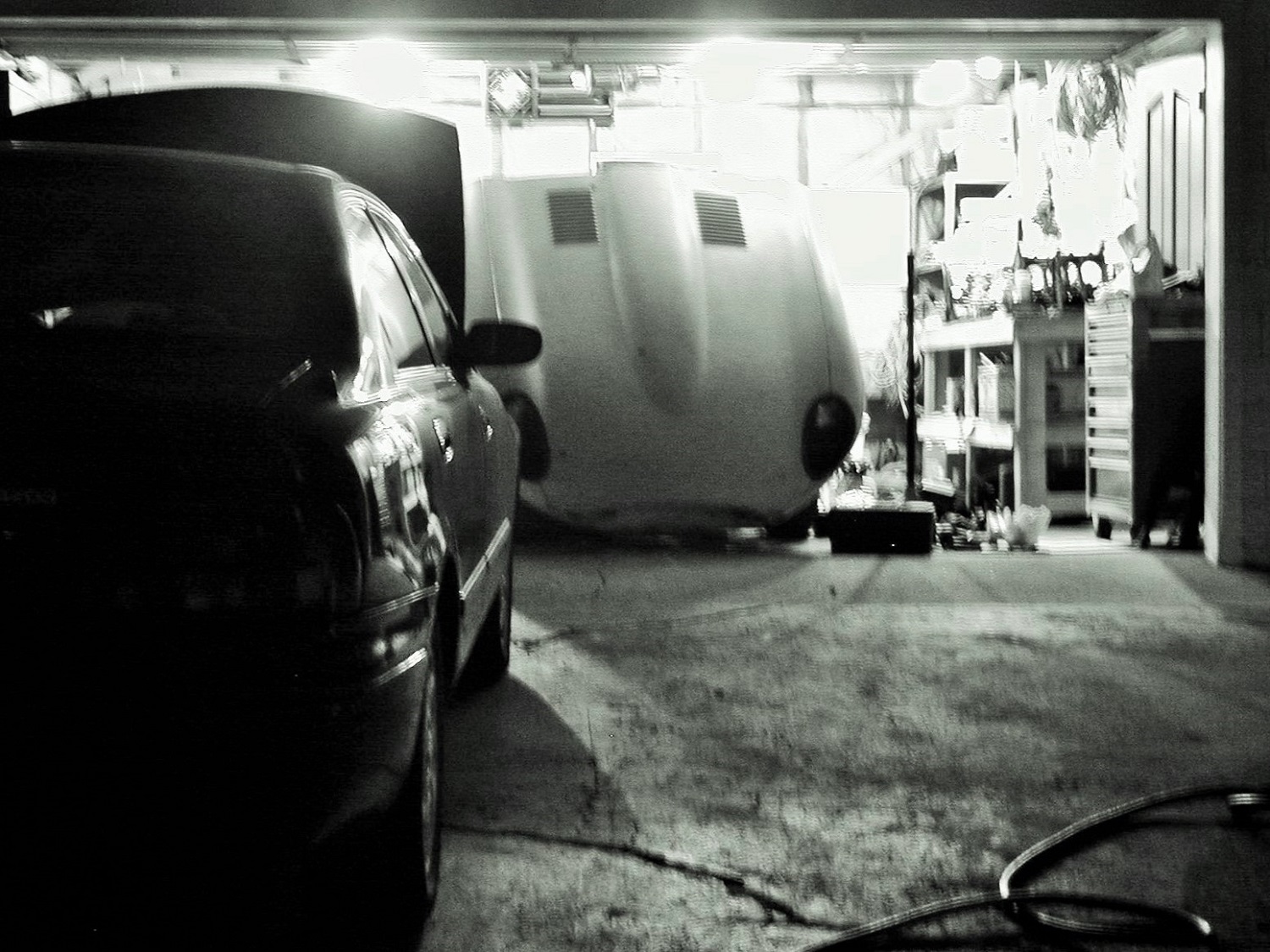
|
|
|
|
|
|
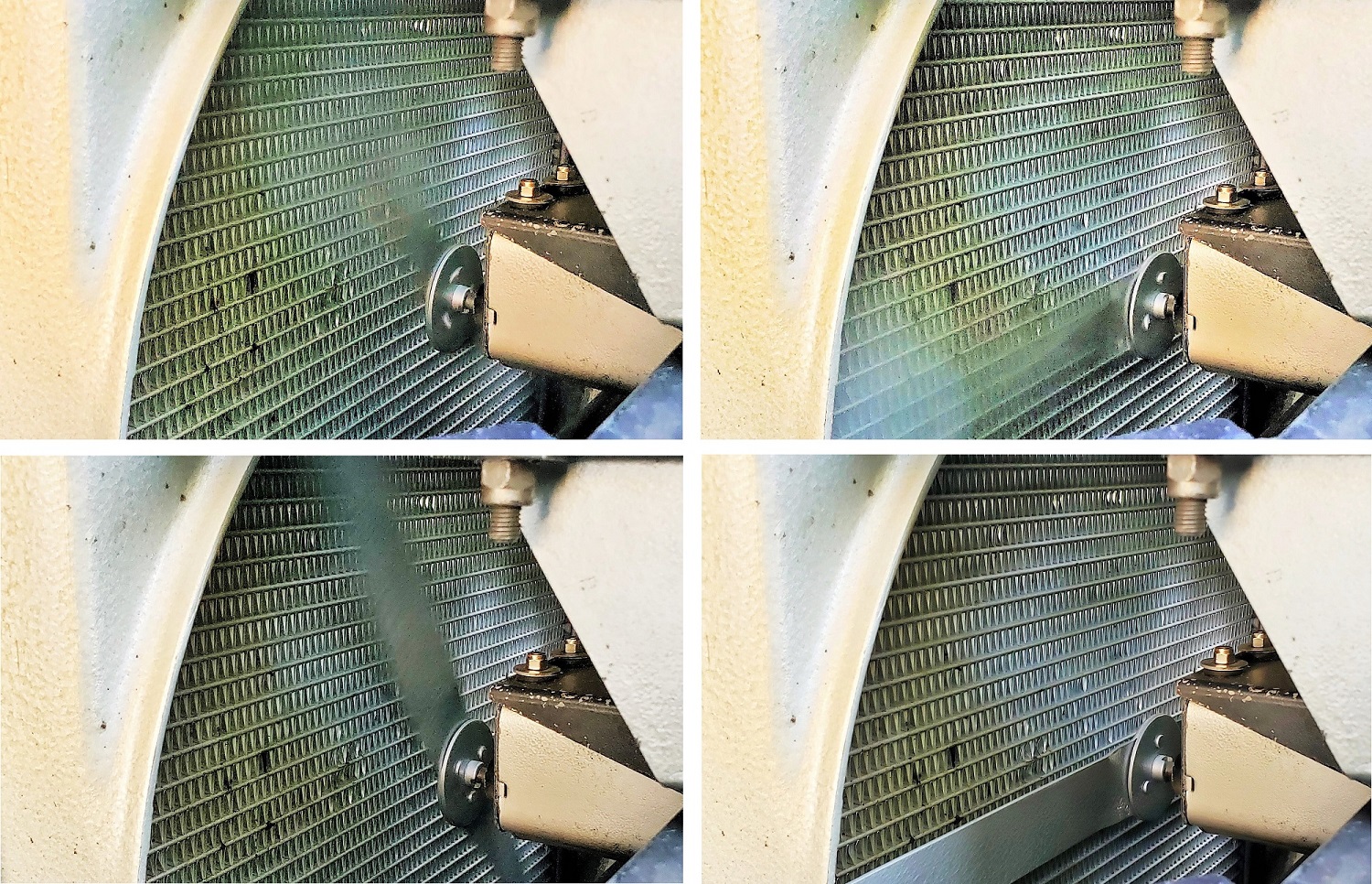
|
|
Cooling fan winding down
When the ignition is turned off, after a drive.
|
|
|
|
|
|
Early morning drive
|
|
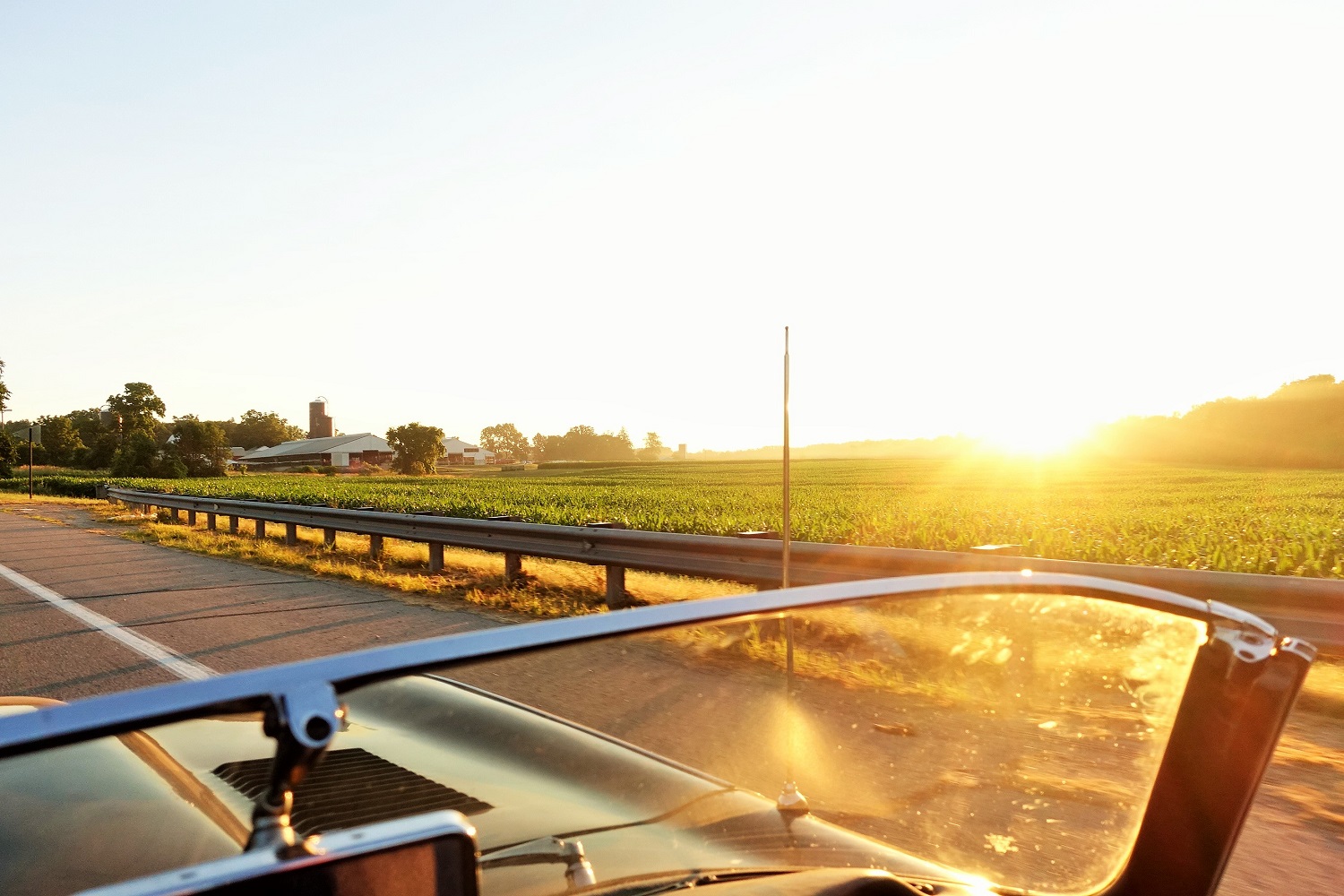
|
|
|
|
|
|

|
|
3.8-liter E-type fuel filter assembly
The glass sediment bowl collects debris by gravity. There is also a filter in the top to take out smaller particles.
When the bonnet-latch design changed from outside to inside the exact location of the filter unit changed, as discussed on page 191 of the newOriginality Book. This is the eariler configuration.
|
|
|
|
|
|
E-type Jaguar parked on the street
Fall scene of an E-type sitting.
|
|
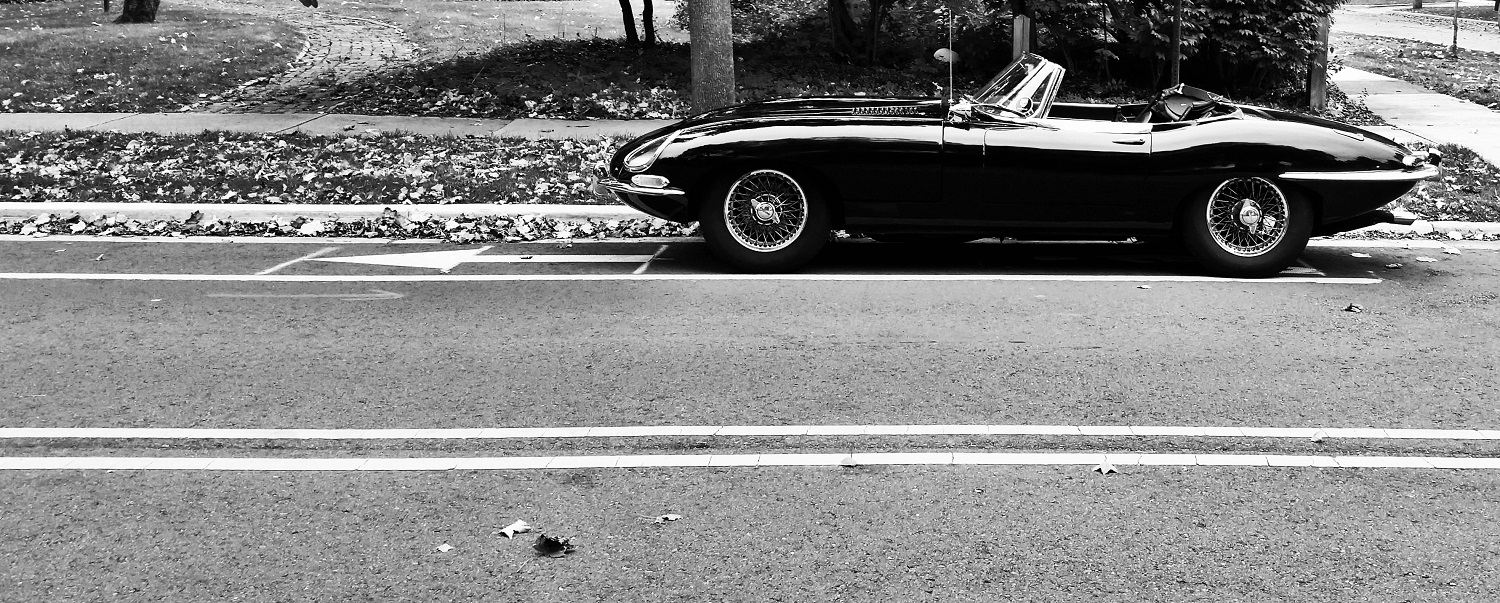
|
|
|
|
|
|
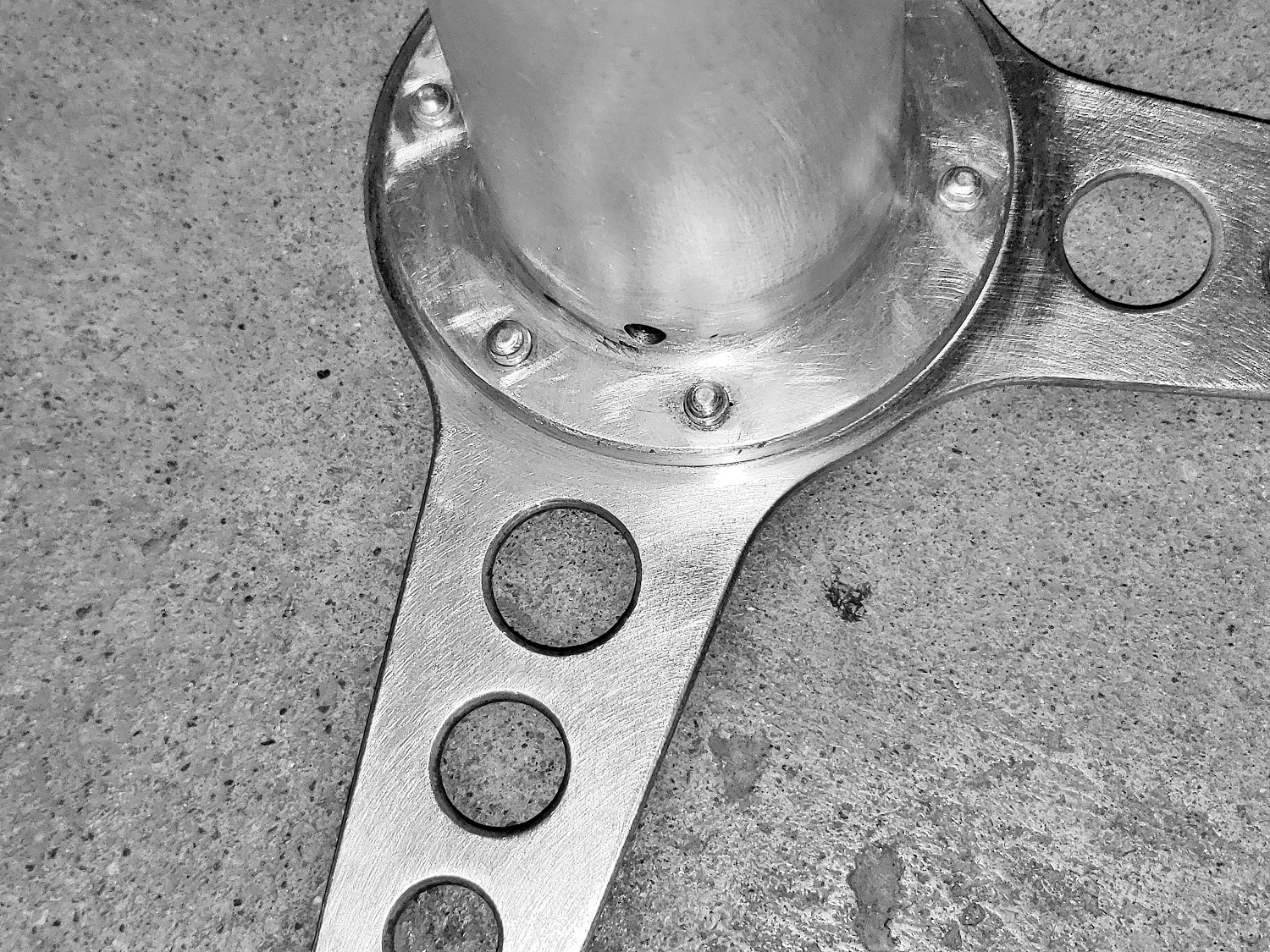
|
|
View of the back of a Series 1 or 2 steering wheel
One of the exceptionally beautiful parts of the E-type, this aluminum steering wheel is in the initial stages of being refinished. In its Series 1 guise, it would have been polished, as this one is planned to be.
This is one of the many parts that seem to be described by Peter Egan in the May, 1997 Road & Track: "The car seemed to have a hundred individual parts you'd gladly display in a trophy case; it was a virtual mother lode of future paperweights, conversation pieces, heraldic wall hangings and Druidic totems, all compacted into a single kinetic object of amazing sensuality and grace."
This observation applies well to most of the parts shown on this website.
Some other pictures of the E-type steering wheel on this site can be seen:
here (with an aftermarket leather cover),
here (an early-style wheel undergoing wood refinishing),
here, (steering wheel on dash),
here (an early-style wheel damaged from an accident),
here (rear view),
here (another steering wheel on dash),
here (an early-style wheel in original condition on dash),
here (a restored later-style wheel),
and here (close up of the original finish on an early-style steering wheel).
|
|
|
|
|
|
Discussion of radios in the new originality book
This is a view of page 420 of the new book. The series of pictures on the left shows the selection of many different bands on a Smiths 530T "Wave Change" radio.
The drum position is set by turning the rear knob on the right.
|
|
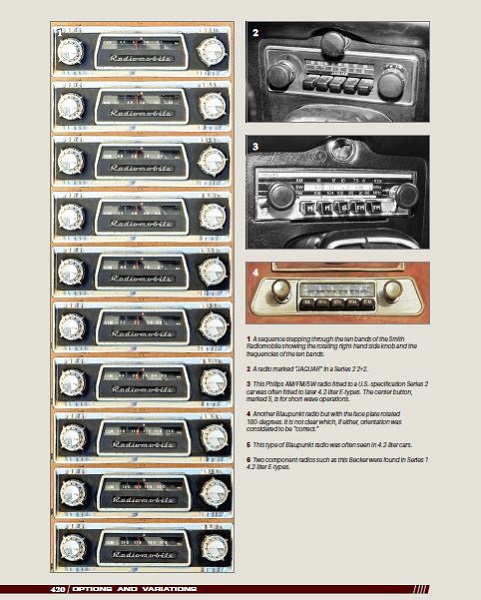
|
|
|
|
|
|
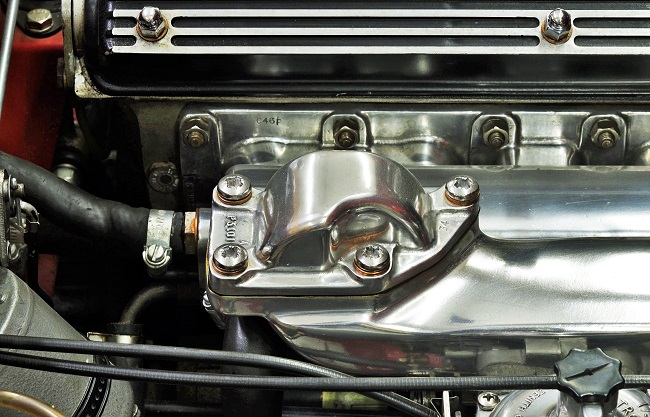
|
|
A later stage of a Series 2 intake manifold
This aluminum cover replaces the crossover pipe used on earlier U.S. emission control cars.
The finned cam covers introduced with the Series 1.5 cars is seen at the top of the picture.
|
|
|
|
|
|
T-key cover escutcheon
These spring-loaded covers were positioned over the T-key holes on the first 500 E-types produced.
The covers were delicate, and often broke off.
They were also used on Triumph cars and Jaguar Mk V sedan fender skirts. XK-120 fender skirts had simlar covers, but they were round in shape and less ornate.
|
|
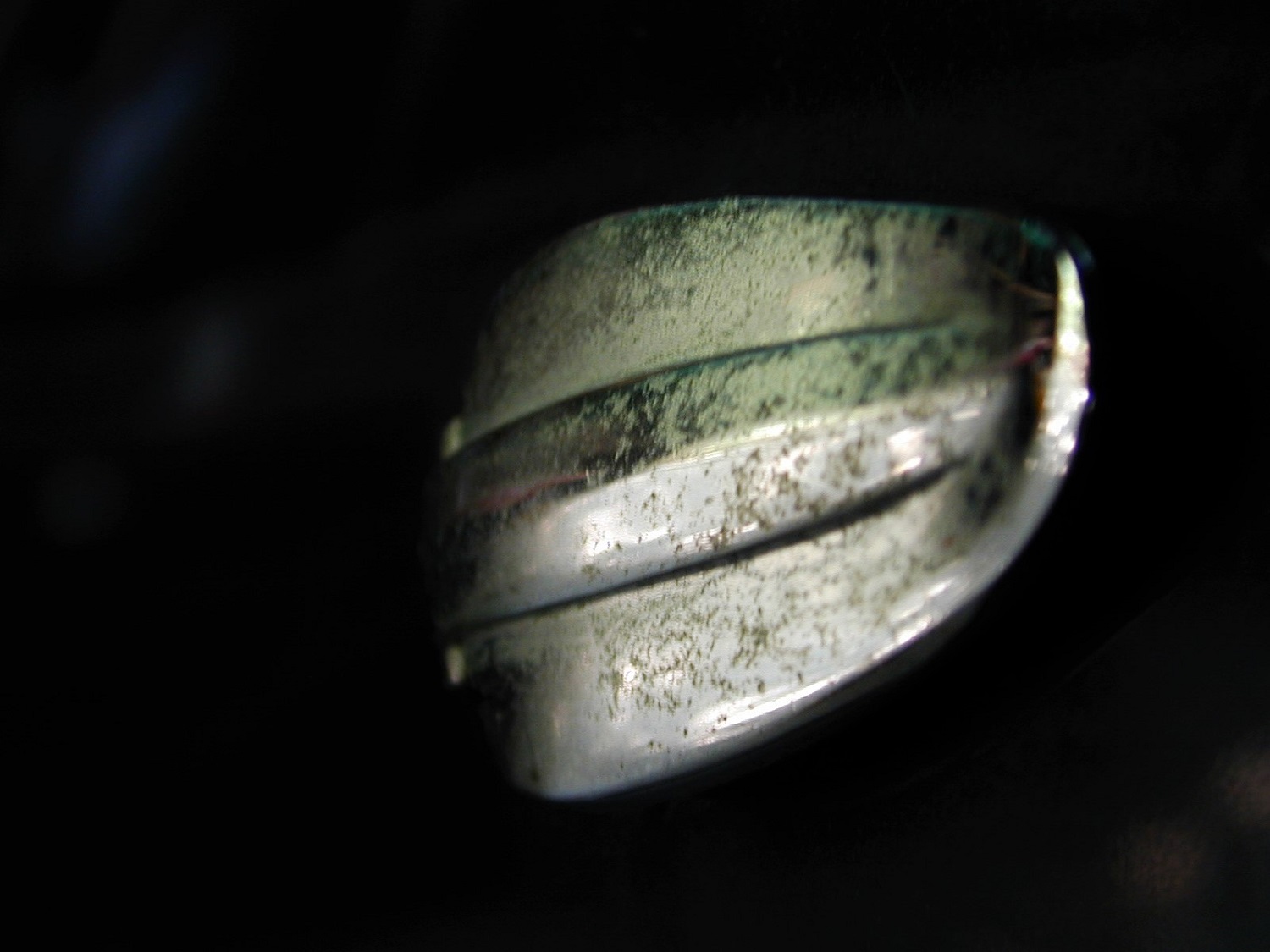
|
|
|
|
|
|
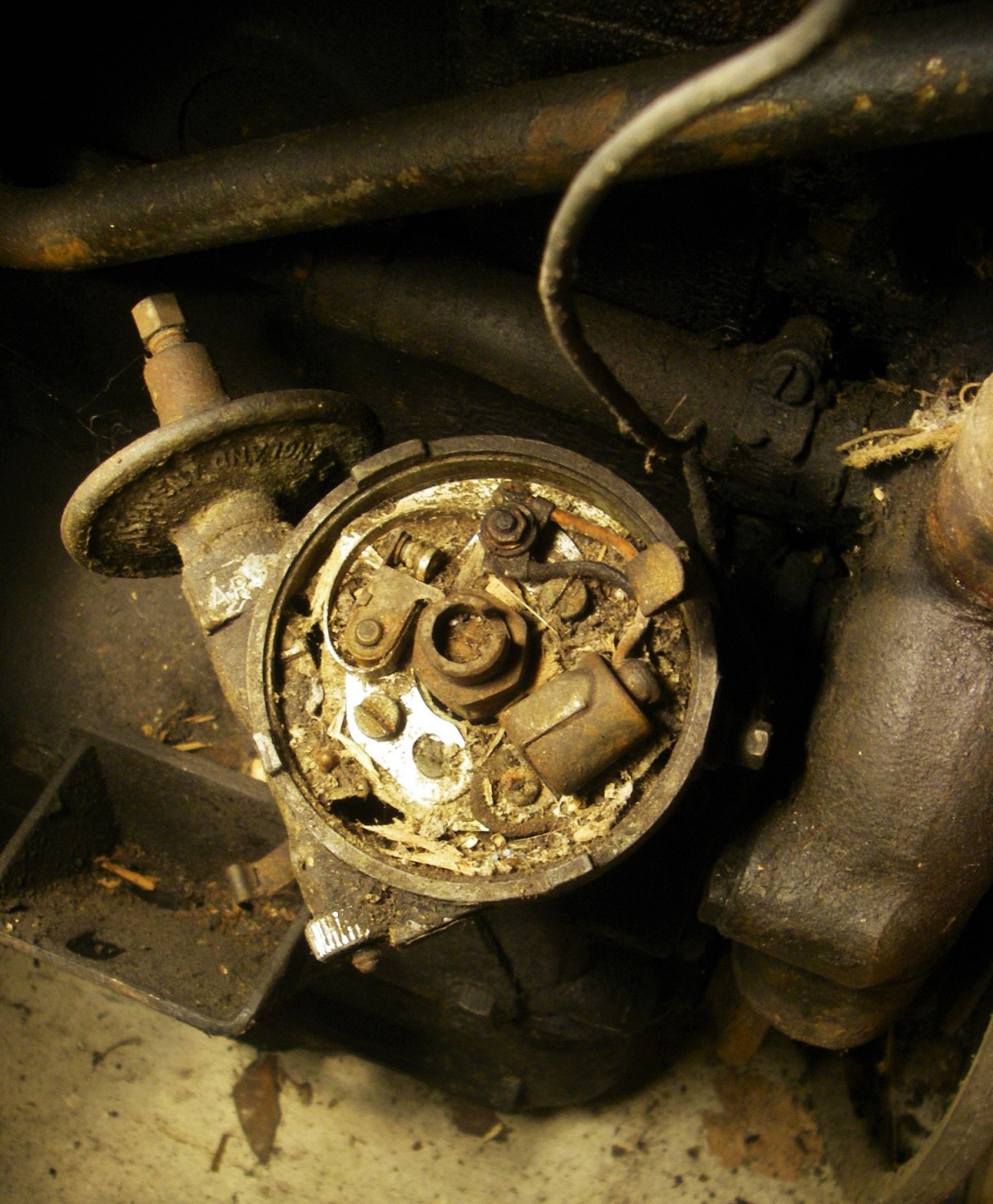
|
|
Lucas distributor
This distributor is missing its cap and contains debris from long storage.
The screw-on vacuum-advance line is missing here.
|
|
|
|
|
|
Hub cap and splined hub
This view of a rear wheel hub shows the beautiful cast hubcap.
The brass material used for the casting was finished with polished chrome plating. In the understated manner found throughout the car, the expensive material is not even displayed.
The name "JAGUAR" is cast into its face (unlike most cars of the era that carried anonomyous hubcaps).
Also especially notable in this picture is lack of a brake at the hub; rear brakes were mounted inbord.
|
|
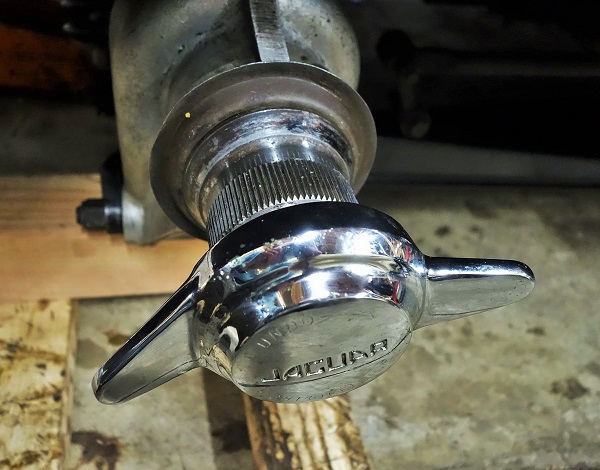
|
|
|
|
|
|

|
|
XK engine crankshaft
This view of the seven main bearing crankshaft from a 3.8-liter E-type engine clearly shows the sturdiness of the design.
|
|
|
|
|
|
"E JAG" sticker
"E JAG" stood for "Eastern Jaguar Group," a club operating on the east coast of the U.S. and based in Westford, MA.
While the name suggests the club focused on E-types, it actually covered all types of Jaguars.
The club also had members from a much wider geographic range, but today appears to no longer be operating.
|
|
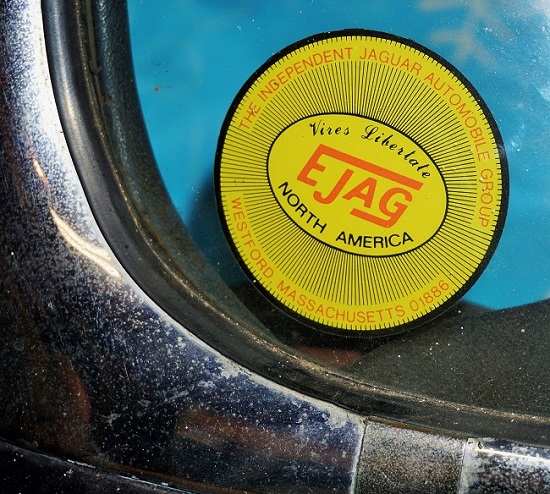
|
|
|
|
|
|
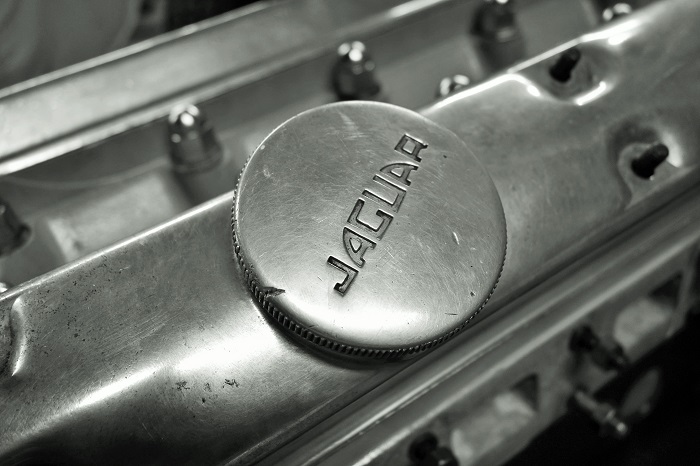
|
|
Classic detail of the XK engine
The oil-filler cap with incuse "JAGUAR" lettering cast in.
This beautiful detail was part of all XK engines from the XK-120 on through the Series 1 E-types, and somewhat beyond.
Subsequently, the cast caps were plain and did not carry the "JAGUAR" lettering.
|
|
|
|
|
|
Series 1 E-type roadster
This car needs some attention to details, but is overall reasonably presentable.
|
|
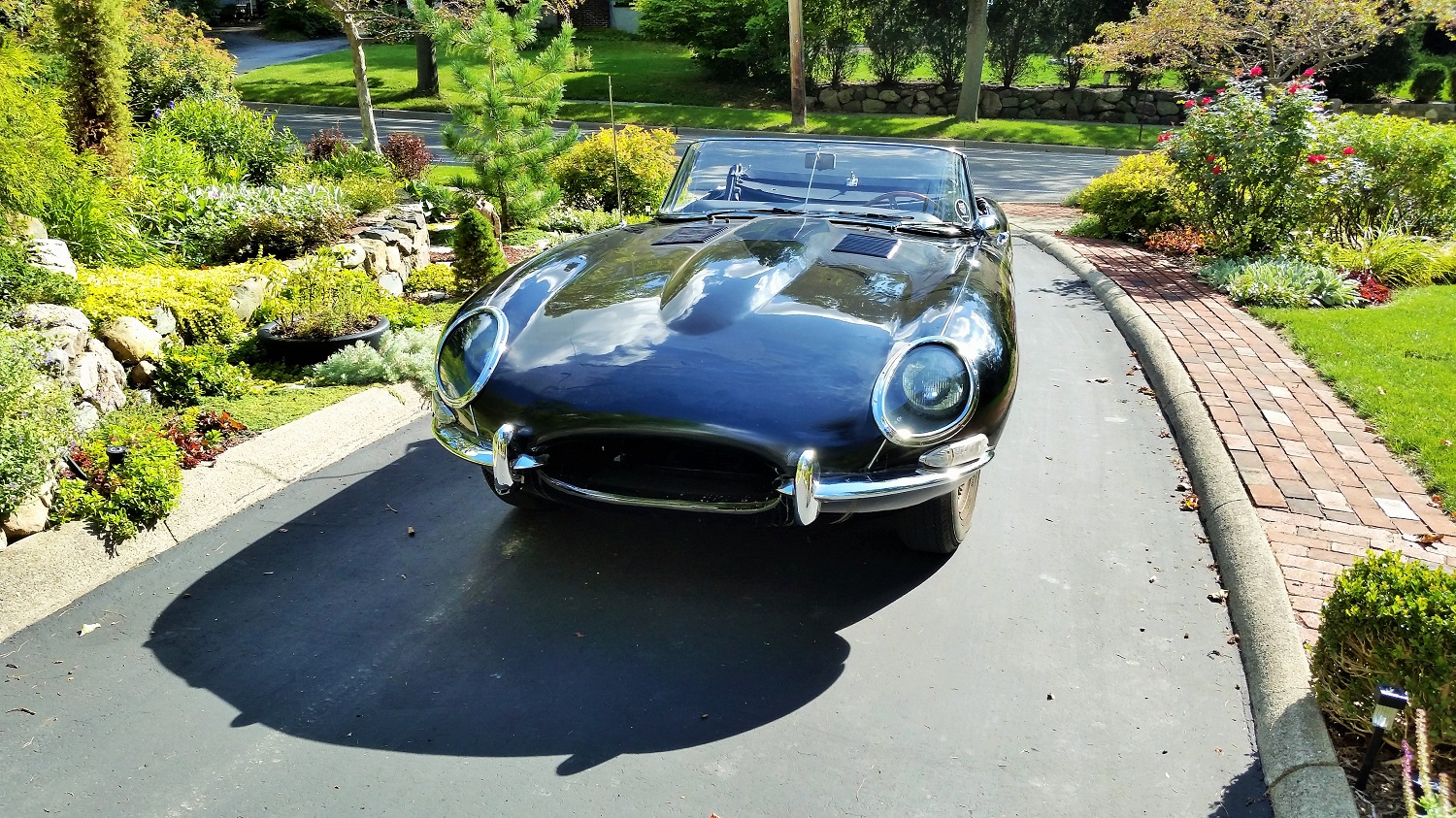
|
|
|
|
|
|

|
|
Series 1 2+2 dash
The late version of the toggle-switch central dash layout is seen here on a 2+2 coupe. By this stage of development the central dash trim material had been changed from the latter type of aluminum trim to the black trim.
The choke and choke warning light have been configured here to permit the fitting of the fluted chrome knob seen in the lower right of the picture. This knob controlled the direction of ventillation air in a continuous manner.
The earlier ventillation control system was comprised of a metal door with a small knob. A spring toggled the door to be either open or closed, but did not permit it to take an intermediate position.
|
|
|
|
|
|
Cam cover nuts
As with the cylinder head, the camshaft covers were retained by chromed domed nuts.
This is just one of the appealing details found on XK-engined Jaguar cars.
|
|
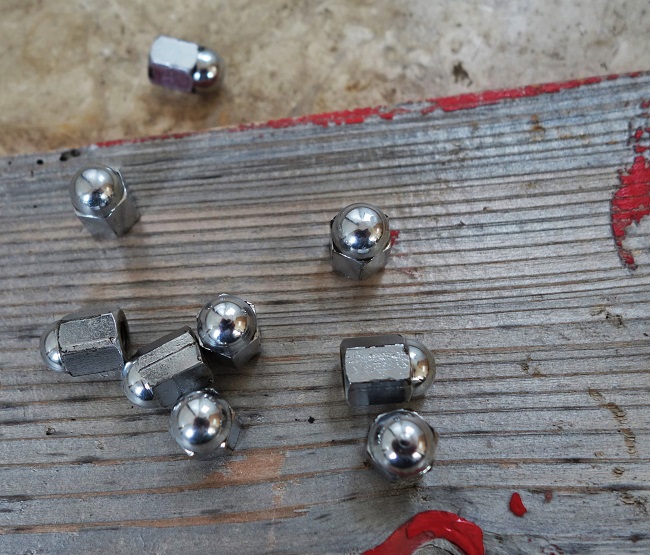
|
|
|
|
|
|
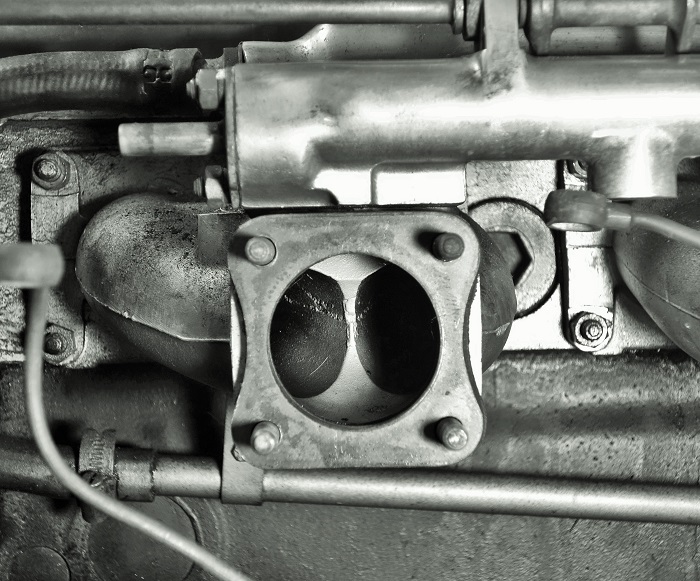
|
|
Rear 3.8 intake manifold
A view looking into the intake end of the rearmost of the three intake manifolds.
Here the bifurcation of the intake air-fuel mixture flow path is seen.
The rear branch (on the left side of the circular intake) feeds cylinder number one (the rearmost cylinder), and the forward branch (to the right) feeds cylinder number two.
Recall the cylinders in the XK engine are numberd from the rear forward; number one at hte rear, number six at the front.
|
|
|
|
|
|
Headlight trim
Initially the headlight trim was held on by slot-head screws. Phillips screws were later used.
This is the "LUCAS" sealed-beam headlight. Some very early U.S.-market cars had "GE" sealed-beam bulbs. See, for example, one here.
|
|

|
|
|
|
|
|
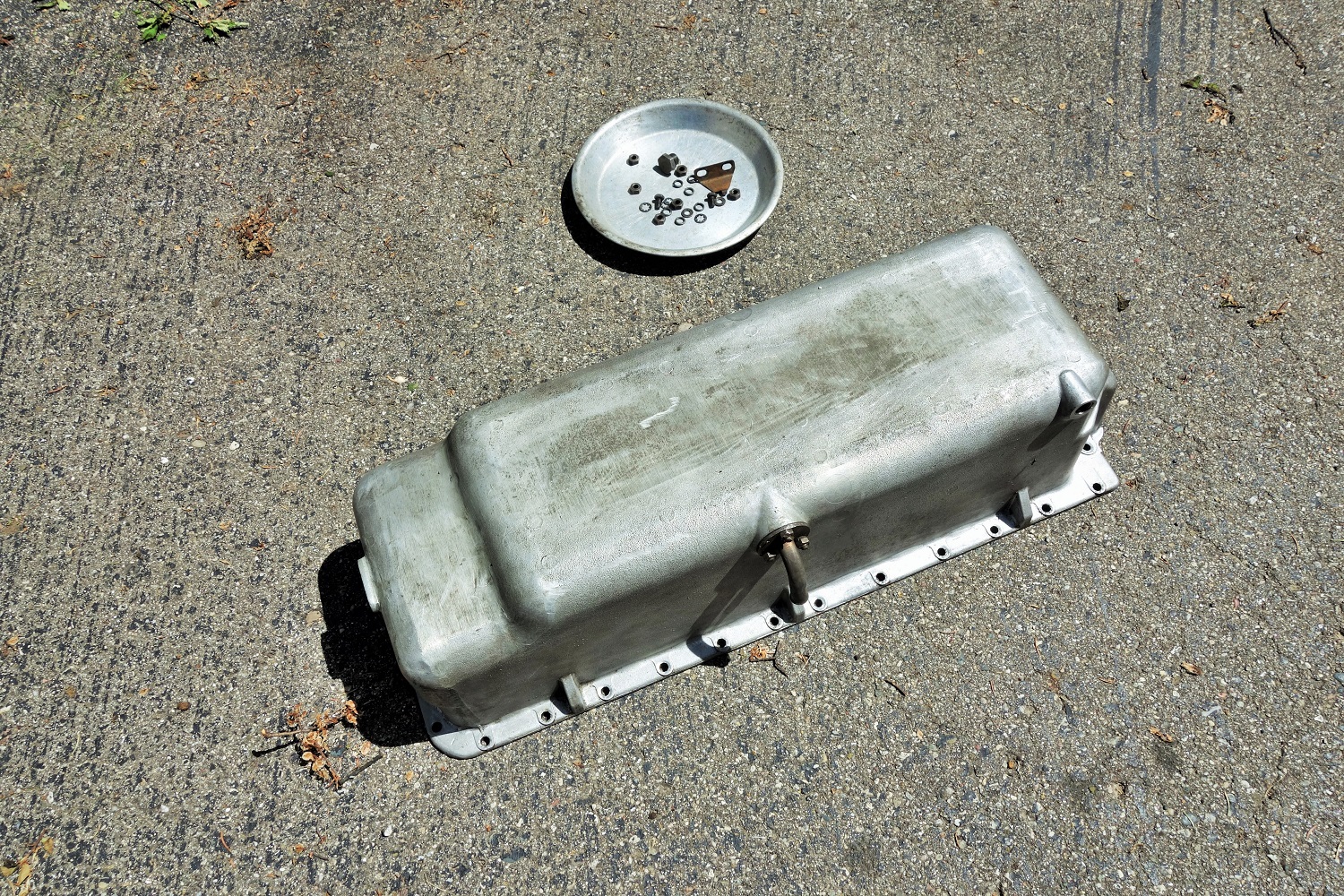
|
|
Non-finned XK-engine sump
All XK-engines supplied by the factory in E-types had cast aluminum sumps.
The early sumps, as shown here, had smooth sides. Later, cast-in cooling fins were included in the design.
While many Jaguar models used cast aluminum sumps (of various shapes, depending on the model), others had sumps fabricated out of sheet steel.
|
|
|
|
|
|
HD8 carburetors
The 2-inch throat, sidedraft SU HD8 carburetors were used throughout E-type production from 1961 to 1967 in the U.S. and somewhat longer for other markets.
|
|
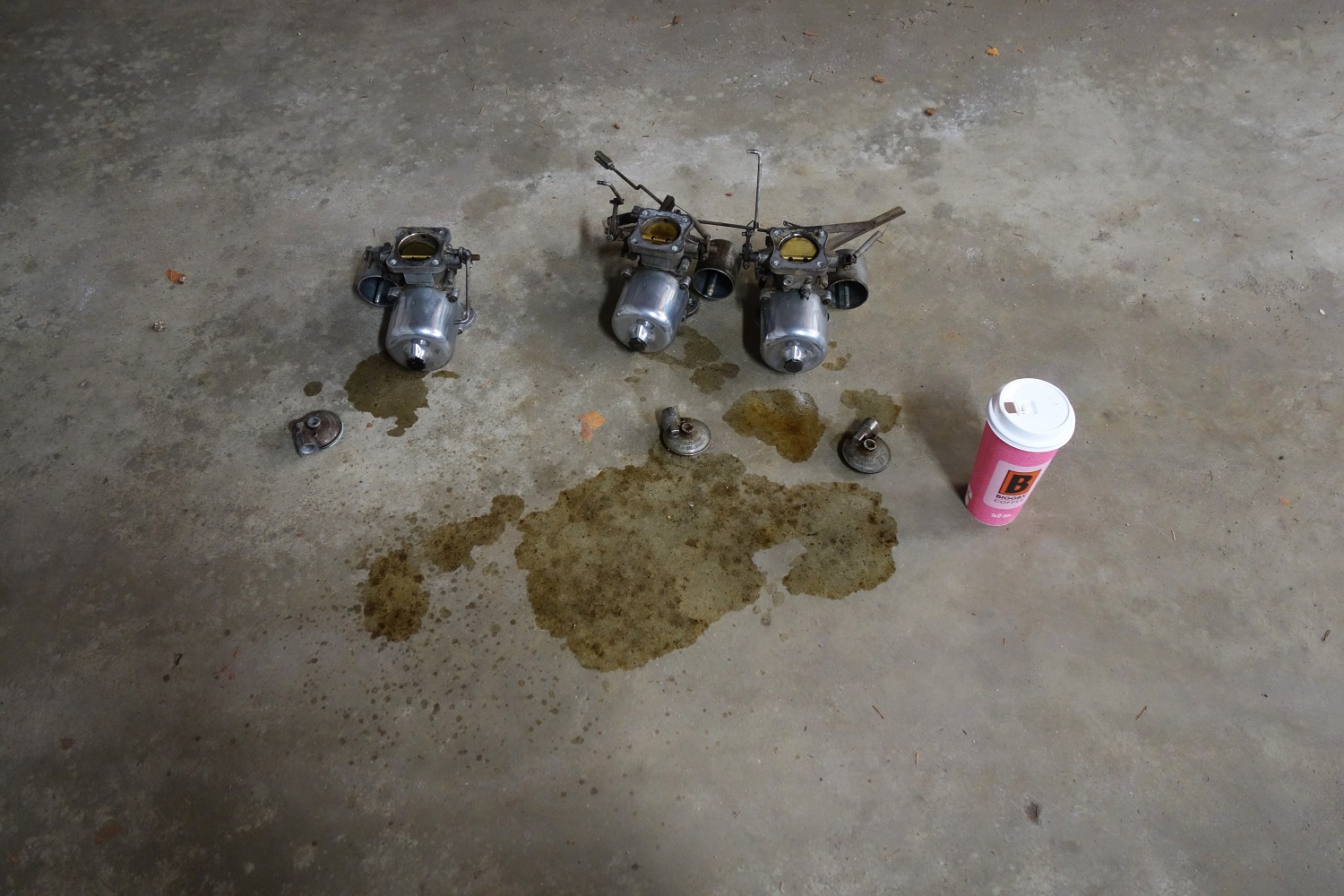
|
|
|
|
|
|

|
|
E-type in the rain
A sheet of plastic shields this E-type from the rain (to some degree).
|
|
|
|
|
|
XK engine block with hole from thrown rod
This stripped engine block has a hole from a thrown rod on cylinder number six.
|
|
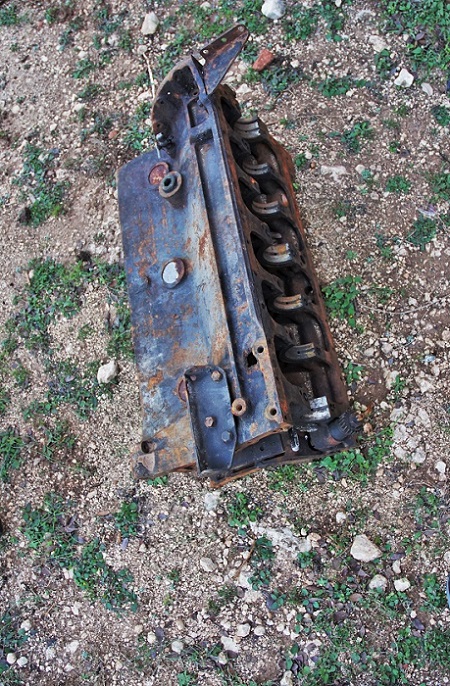
|
|
|
|
|
|
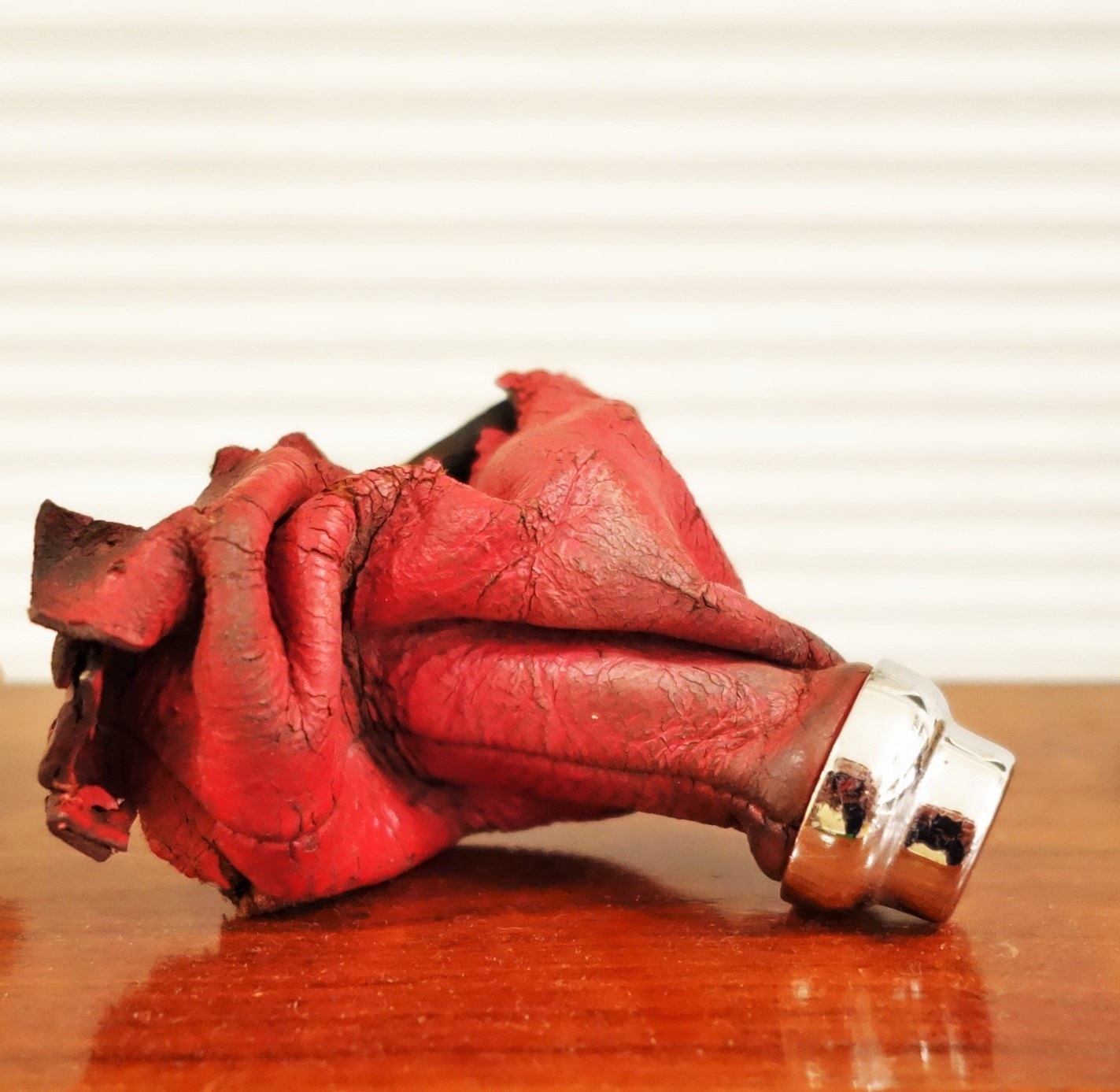
|
|
Leather shift boot from a Series 1 car
When the E-type first came out, the shift boots were made of leather with a collet at the top.
Later on in production simulated leather was used.
|
|
|
|
|
|
Fuel sender on tank
This fuel-level sender unit is mounted on a tank showing original paint.
|
|

|
|
|
|
|
|
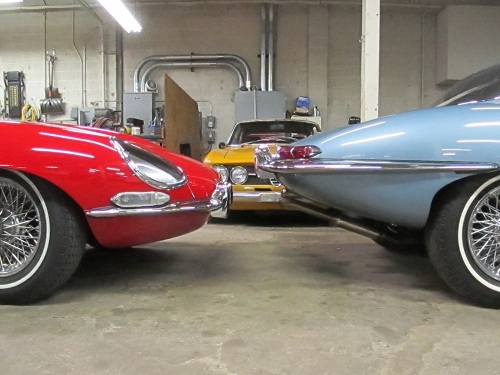
|
|
Lined up E-Types
While British sports cars of the 1950s and 1960s typically had bumpers that did not align with the current U.S. cars, the E-Type is likely the only one that did not even align with its own bumpers, front to rear.
|
|
|
|
|
|
Headlight covers
The fogging of this headlight cover in the rain is one of the optical drawbacks of the covers, even though they are beautiful.
Also showing in this wet scene is a film of oil leaking from the car, another typical feature of Jaguars.
|
|
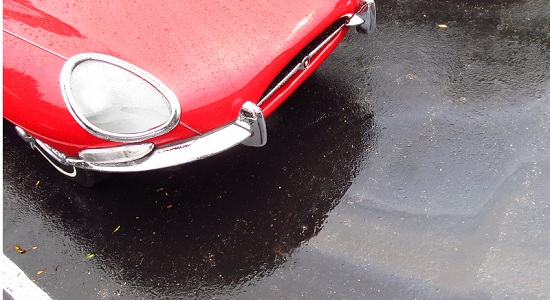
|
|
|
|
|
|
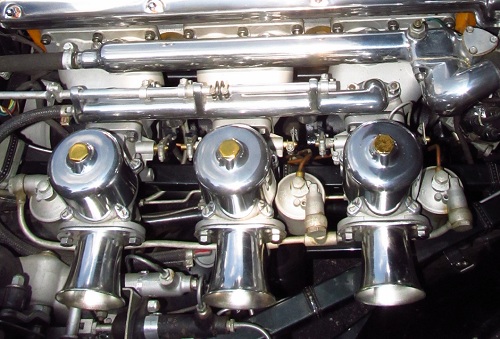
|
|
Ram pipes on an early 3.8 liter engine
Ram pipes were a common performance option on E-Types.
This very early car also shows the multi-piece throttle linkage across the air equalizer pipe.
|
|
|
|
|
|
Use in the winter
There are not too many scenes like this now.
|
|

|
|
|
|
|
|
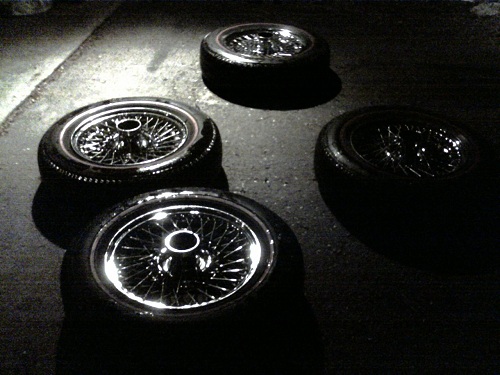
|
|
Red line tires
Red line tires were commonly used when E-Types were current.
|
|
|
|
|
|
Engines in Storage
XK engines awaiting their next use.
|
|
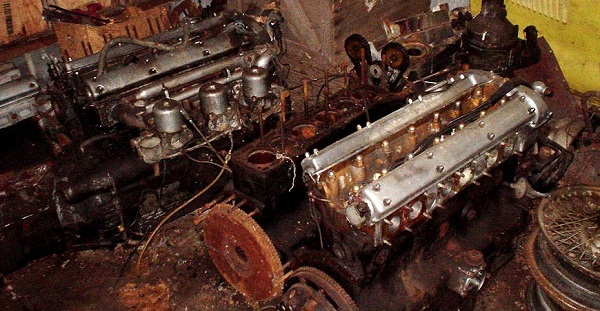
|
|
|
|
|
|

|
|
Tachometer drive
This test system for an E-Type tachometer shows both the analog generator rotational-velocity transducer and the tachometer.
The tachometer is actually a voltmeter reading off the voltage generated by the generator. The Generator is mounted at the rear of the intake camshaft.
The cable protruding from the back of the tachometer, to the right of the picture, is to set the clock.
|
|
|
|
|
|
Badge bar evolution
On the left is the original Series 1 badge bar, followed by the Series 2 and finally the V12 Series 3.
|
|

|
|
|
|
|
|
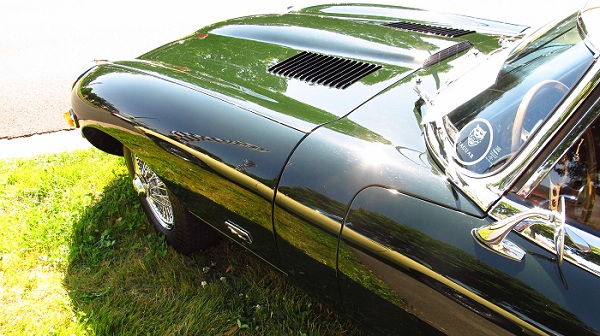
|
|
Series 2 in a show
This late Series 2 roadster shows the leaping cat escutcheon on the lower rear of the hood, in roughly the same position as the exterior hood latches used on the first 500 E-Types.
|
|
|
|
|
|
4.2-liter E-Type carburetors and intake manifold
With the advent of the 4.2-liter E-Type engine the multi-piece intake manifold configuration was dramatically reduced to a single-piece casting.
|
|
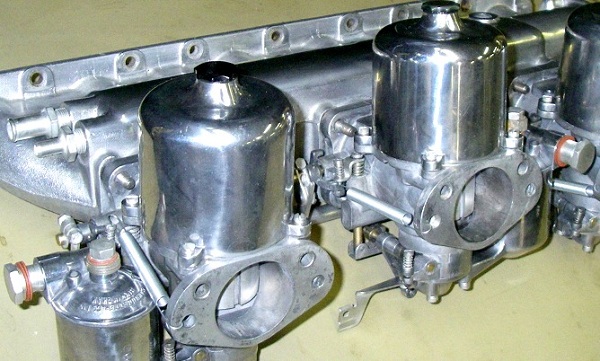
|
|
|
|
|
|
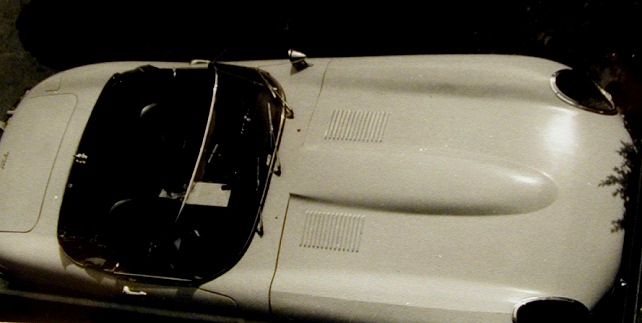
|
|
Rust repair from the 1960s
Agressive rust on the hood of this 3.8-liter roadster was quickly repaired by swiping plastic body filler across the line from the top of the beading to the tangential point on the fenders, giving the car an Arnolt-Bristol look.
This sort of ad-hoc body repair was common in the northern US as E-Types made the transition from stunning exotics to rusty used cars, with the associagted fall in value.
|
|
|
|
|
|
3.8-liter intake manifold from a Mk X sedan
While the gold-top 3.8-liter engine was fitted to both the E-Type and the Mk X sedan, there were many differences between the two.
Some of the differences seen here are the fitting of a temperature sensor to control the starting carburetor in the space where a blanked-off plate is used on the E-Type manifold, and the spring-loaded fasteners attaching the carburetors to the manioflds.
|
|

|
|
|
|
|
|
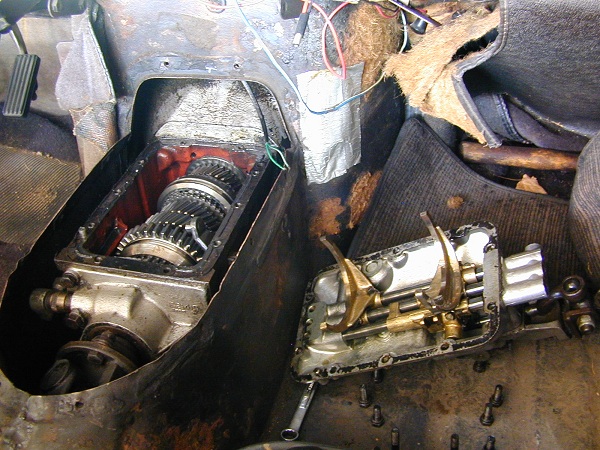
|
|
An opened-up Moss gearbox
This Moss gearbox is opened up to free up a stuck first gear.
These traditional Jaguar gearboxes often had a tendacy to stick in first gear, requiring direct access to the gears to be feed-up. This was in spite of a blocking post introduced years earlier to prevent this effect.
|
|
|
|
|
|
Left rear bumper on a Series 1
Another example of E-Type rust: this bumber has rusted out from the inside, leaving only a thin layer of chrome that broke through.
|
|
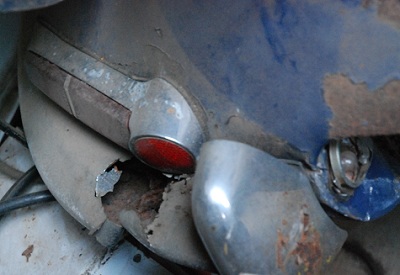
|
|
|
|
|
|
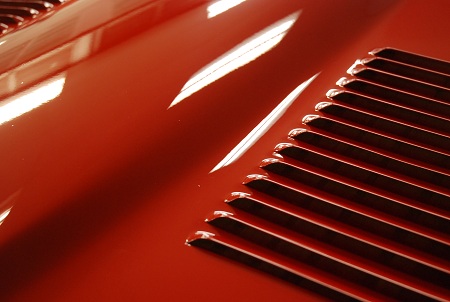
|
|
Freshly-painted hood.
This hood center section on a 3.8-liter coupe has just been panted Carmen Red, and is awaiting polishing.
|
|
|
|
|
|
Outside latch fender
The escutchen over the T-key hole was held on by two screws.
|
|
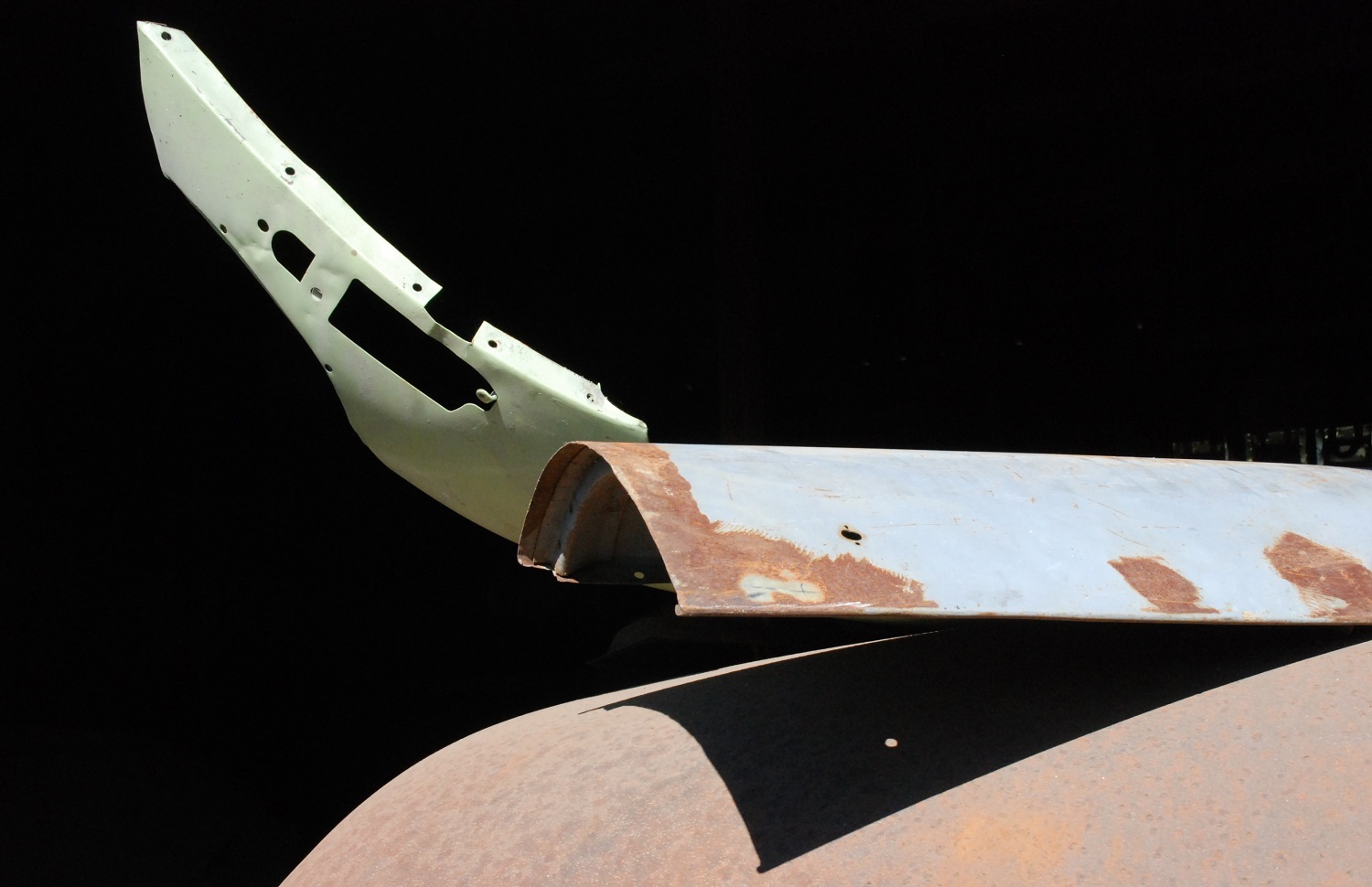
|
|
|
|
|
|
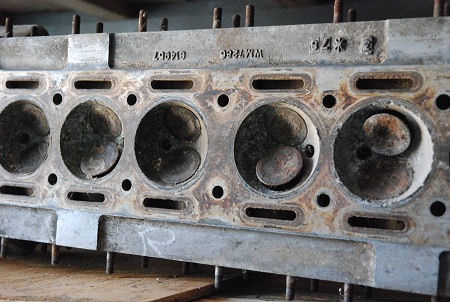
|
|
Cylinder head
View of the combustion chambers.
|
|
|
|
|
|
Early coupe rear quarter
A beautifully restored outside-latch coupe.
|
|
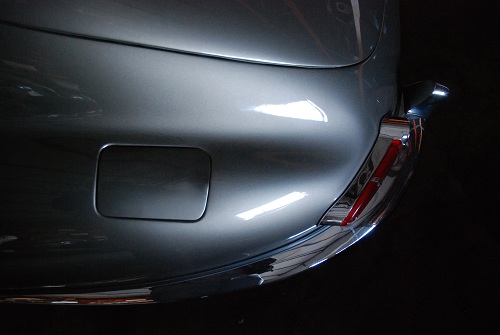
|
|
|
|
|
|
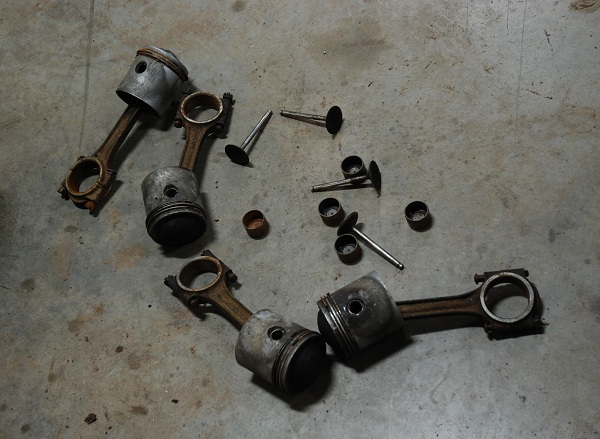
|
|
XK engine parts
Some pistons, connecting rods, valves and tappets from a 3.8-liter XK engine.
|
|
|
|
|
|
View into a tappet guide
Sometime in the past a wasp made a nest inside this tappet guide in an XK cylinder head. As the cars are very old now, over half a century, they exist in various conditions and environments.
|
|
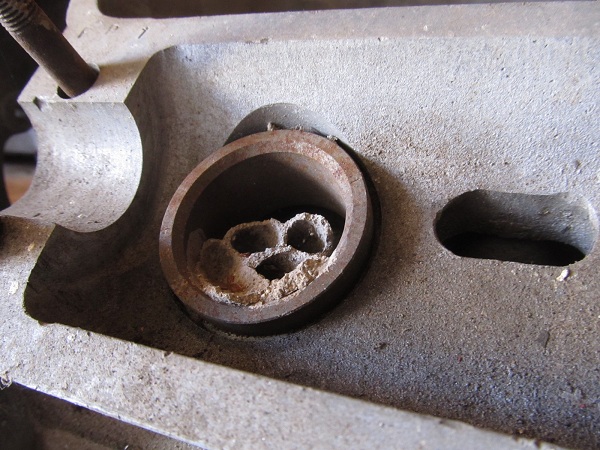
|
|
|
|
|
|
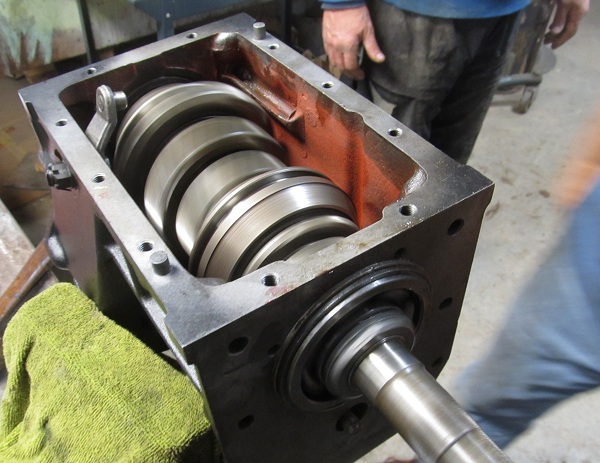
|
|
Moss gearbox
While produced by Jaguar, the "Moss gearbox" was an old design produced by the Moss Gear Company of Birmingham.
Here the mainshaft and input shaft of a Moss gearbox are spinning together during the re-assembly stages of a gearbox to be used in an 1961 E-Type. This test was done without the layshaft engaged.
|
|
|
|
|
|
Early 1970s view
This view of a midwest summer in the early 1970s shows a contemporary U.S. car of the period - a Buick GS 400 coupe in silver blue paint with black vinyl roof.
The GS 400 in the background gave straight-line performance comperable to the E-Type shown in the foreground, but with much less handling capabilities.
|
|

|
|
|
|
|
|
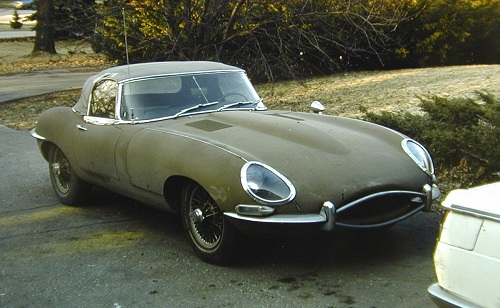
|
|
West-coast 4.2-liter roadster
This E-Type was used in California, and shown no rust at a period when many east-coast cars were very rusty. The picture was taken in the early 1970s.
It does show, however, the oxidation of the paint that is typical in cars from a sunny climate that were not cared for and spent most of their time outside. Sun exposure likely contributed to the convertible top wear. Taken overall, this was not an expensive car in the 1970s when the picture was taken.
The rear of a 1966 Neue Klasse BMW 1800 is showing on the right. The Neue Klasse cars are the one that led to BMW's resurgence as an automobile manufacturer after World War 2.
|
|
|
|
|

